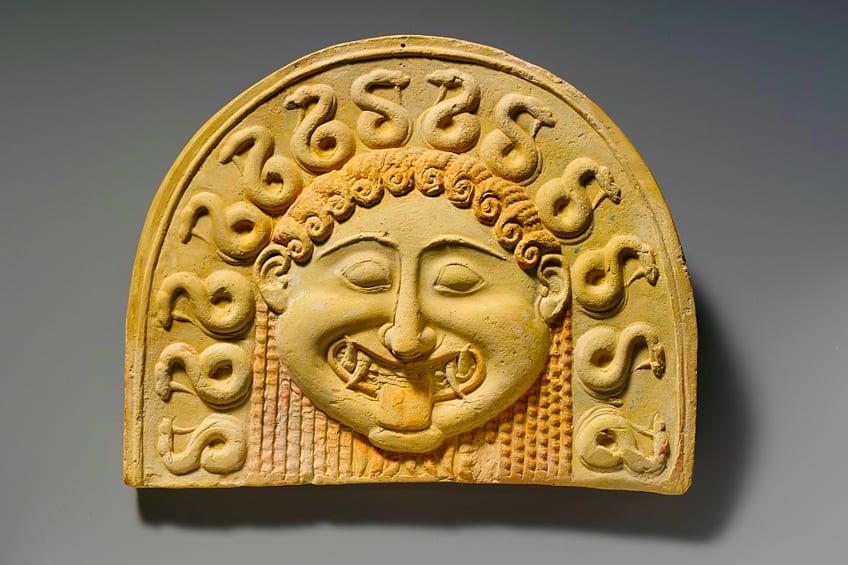Archaic Greek Art – Guide to Pre-Classical Artforms
What often comes to mind when we think of Greek art are the idealized and naturalistic artworks and sculptures of the Classical Age (480 – 323 BCE) or the Hellenistic Age (323 – 32 BCE). But, what led up to that? The art period that preceded them is known as the Archaic period (650 – 480 BCE), a time in Greece of development that set the stage in both culture and politics for the Classical period. In the below article, we will discuss the different types of Archaic art in Greece, as well discuss some well-known artworks.
What Was the Greek Archaic Period?
The Greek Archaic period started in the seventh century BCE, occurring before the Classical Age (480-323 BCE), and was preceded by The Greek Dark Ages. It ended in 480 BCE with the Persians finally being expelled from Greece after the battles in Mykale and Plataea took place in 479 BCE.
The term “archaic” is often used by historians and archeologists to refer to a culture’s earliest phases, and art historians use it to identify the period of artistic development in ancient Greece.
Major changes occurred during this period due an increase of the Greek population, as well as the increase in trade, which resulted in colonization and the formation of new ideas. One of these changes in archaic period Greece was the development of forms of governance based less on inherited kingship, than on choosing leaders through the consent of the people, which powered further cultural changes.
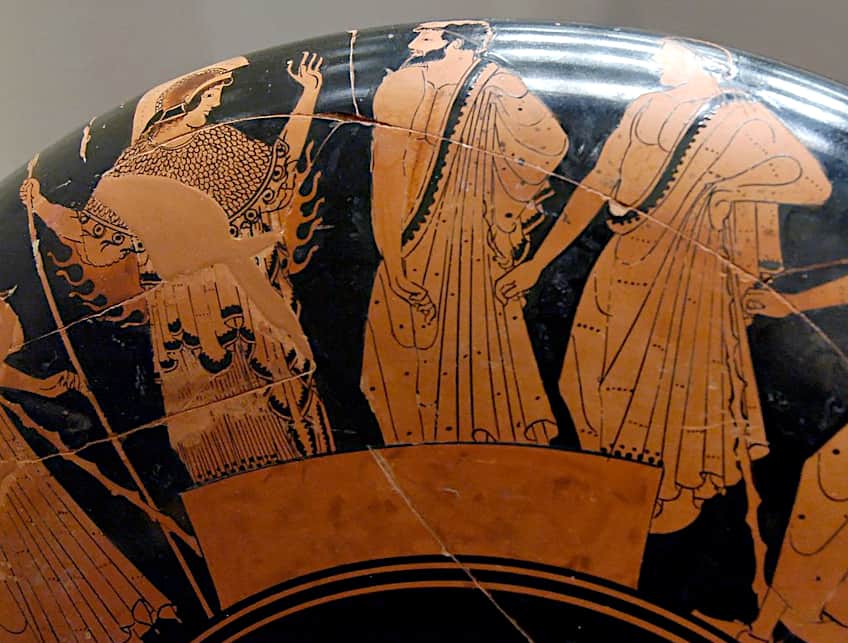
During the seventh and sixth centuries BCE, the Greek world was composed of a number of poleis, which were autonomous city-states that were separated by ridges and the sea. Extending across the coast of Asia Minor, the Aegean Islands, Sicily, mainland Greece, perhaps Spain, as well as North Africa were various Greek settlements.
As their power and wealth increased, there was competition among the poleis on the coast of Asia Minor and neighboring islands, notably in the construction of sanctuaries with huge temples made of stone.
Lyric poetry also gained much success during the Archaic period. It was the most influential literary media at that time, and the work of poets like Archilochos of Paros and Sappho of Lesbos reached new heights. Although the dialect differed from region to region, the Greek language was a major component in uniting people throughout archaic period Greece. People who spoke the language came together for celebrations and games on mainland Greece at important Panhellenic sanctuaries like Olympia or Delphi. Many works of art from western and eastern areas of Greece were dedicated to these holy places.
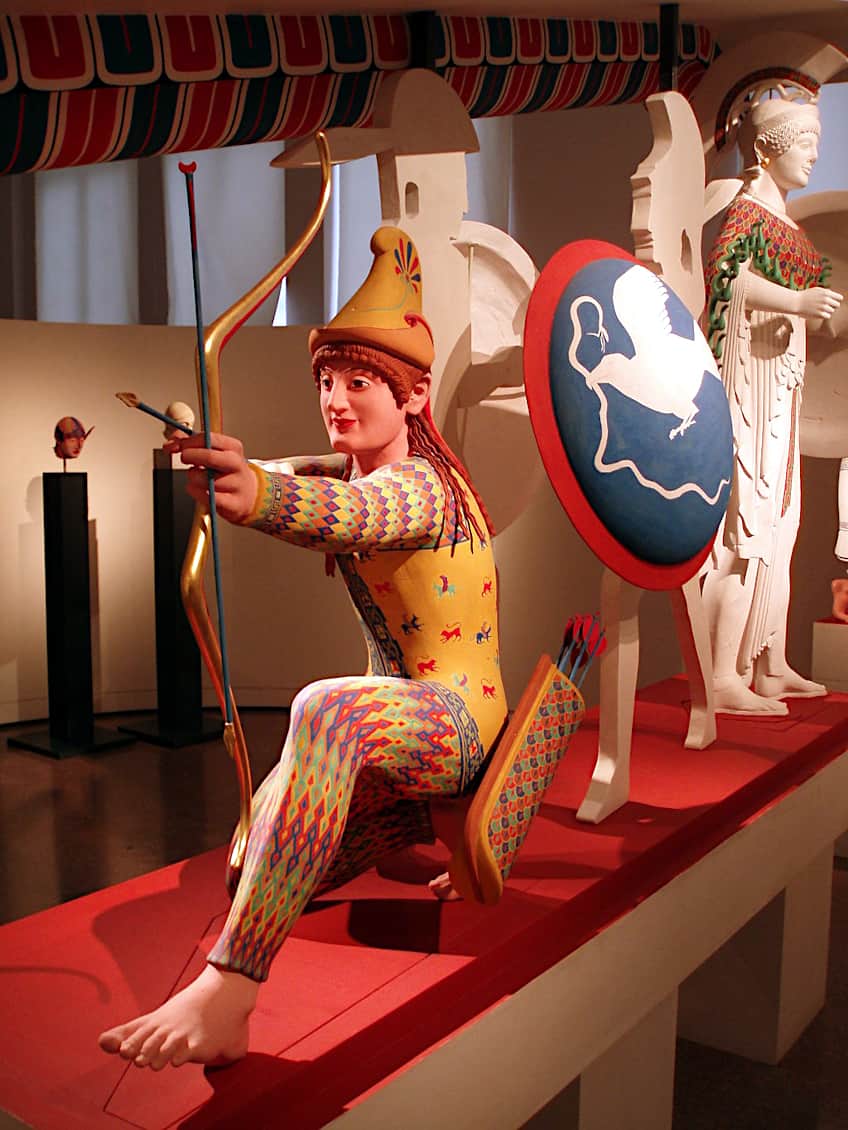
Archaic Greek Art
Before the Archaic period, Greek art was more stylized and rigid in form. During the archaic period we see Greek art became more naturalistic. Vase paintings moved from geometric designs to include depictions of human figures. The faces of sculptures were given life with the “Archaic smile”, a symbol for health and vitality characteristic of the period, while the bodies were given more attention to anatomical detail and proportion. Architectural design also reflected a growing emphasis on harmonious proportions.
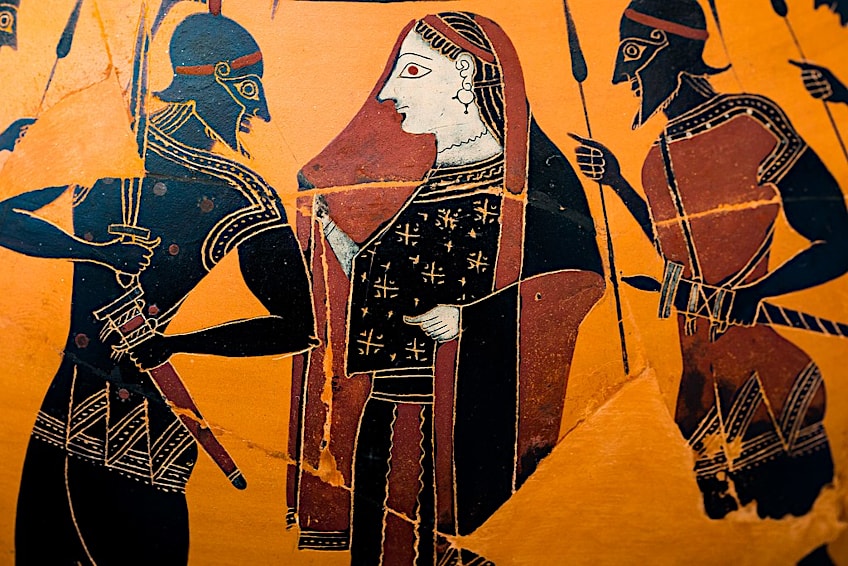
The two main orders of architecture were the Doric order and the Ionic order and by the beginning of the sixth century BCE, they fully secured their place as the primary orders. A process of active experimentation helped to perfect sanctuary architecture through the century. This was typically done through building projects that kings such as Peisistratos in Athens and Polykrates in Samos took on. Paintings (many of which have been destroyed), detailed moldings, and terracotta or stone decorated these structures. In the later part of the sixth century BCE, the development of relief sculpture depicting true narrative arrangements can be seen.
Artists became more interested in motion and depicted human figures performing various activities.
In 566 BCE, Athens invented the Panathenaic games, and along with the occasion being adorned on Greek trophy amphorae, archaic sculptures of triumphant athletes were produced and stood in Greek sanctuaries as dedications. So, what are the two major types of art of the archaic period? The two major types of Archaic period art are pottery and sculpture, which we will discuss in more detail below.
Archaic Greek Pottery
Our understanding of Greek civilization is significantly informed by pottery of ancient Greece, as a large percentage of the archaeological record is made up of Archaic Greek pottery. The best resource for learning the way of life of the Greeks and understanding their worldview are the shards of vases left behind or buried during the first millennium BCE. High-level pottery was purchased from Attica by the Etruscans and other civilizations in the Mediterranean, while many other pots were produced domestically for cooking and daily use.
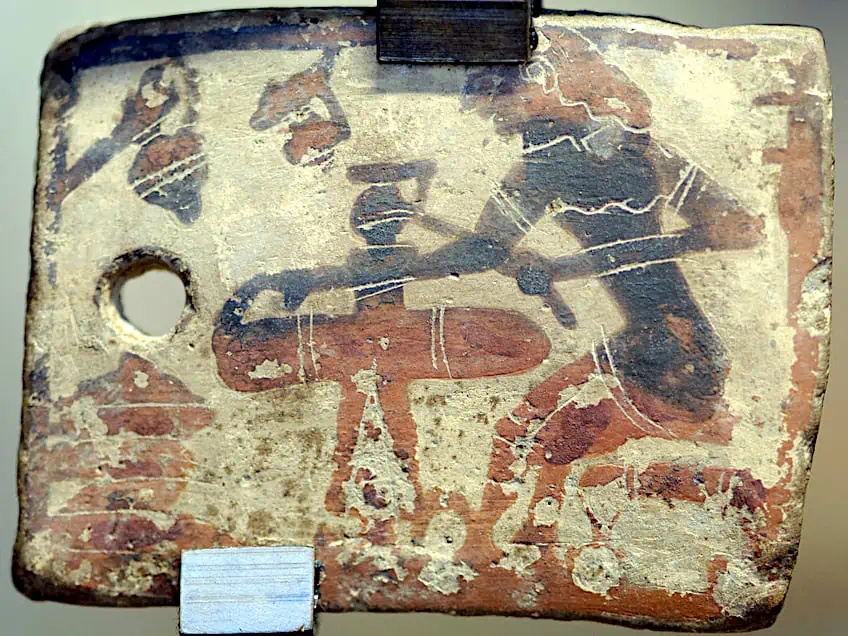
Pottery styles varied between regions, and many different shapes of vases were used. Some vases were used as presents for tombs, while others served as burial markers. Some vases, such as terracotta figurines, seem to have been appreciated as artistic objects in their own right. Some exceptionally beautiful vases made for aristocratic society were ornamental while at the same time serving a function, such as the krater, which was used for diluting and serving wine.
Pre-Archaic pottery involved the use of geometric designs, such as triangles, zigzags, and other shapes on large vases and other containers. From about 700 BCE, as renewed contact was formed between the Greeks and the east, an Oriental style can be observed.
Influence from Egypt and the Near East contributed to the adoption of a more naturalistic style, as well as the use of Eastern decorative imagery, like animal hunts, and beasts such as sphinxes, griffins, and sirens, and lotus and palmette imagery. The Greeks created new depictions of their own customs and myths by absorbing motifs and styles from foreign cultures. Black figure pottery replaced the Oriental style, and the technique developed into red-figure pottery in 530 BCE.
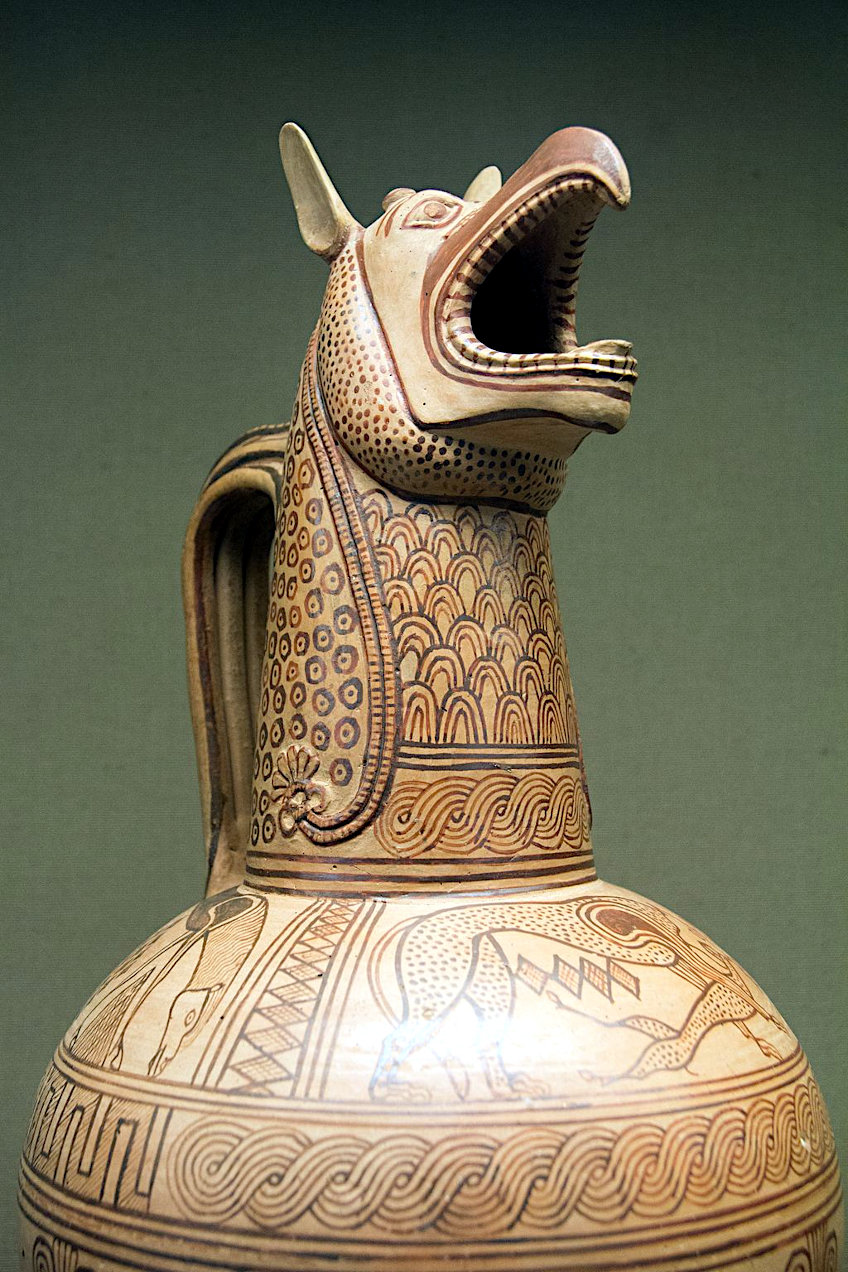
Archaic Greek Sculpture
Archaic art was influenced by the Greeks’ contact with flourishing centers, such as Sardis. Large statues were created in marble by sculptors on Samos and Naxos and other Aegean islands. Archaic Greek sculpture is especially recognized for its figures of kore and kouros, the first representing female youth and the second, male. These archaic sculptures show an ancient Egyptian influence, with its rigid pose and anatomical proportions. They were erected outside of the city walls, in cemeteries and sanctuaries, and were used as grave-markers or served as dedication to the gods.
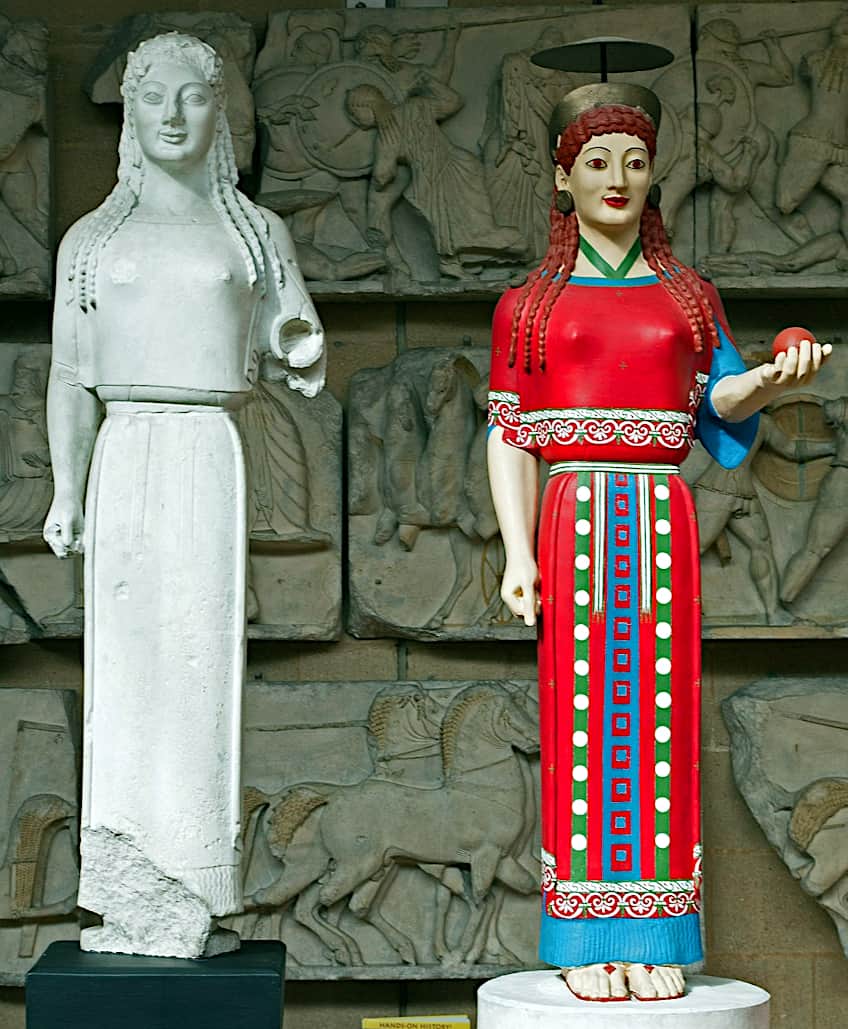
Expensive burial monuments were regularly made by Athenian nobles in the city and surrounding areas. It was particularly common to have them built for relatives who died young. Monuments such as these were shaped like stelai (columns or upright rocks) that were often decorated in relief. Sanctuaries were centers for creativity during the Archaic period and therefore, were important storehouses for artworks.
Famous Archaic Greek Artworks and Artifacts
The leading centers of art on mainland Greece showed notable differences between the regions, particularly Corinth, Sparta, and Athens. Distinctive bronzes and extraordinary ivory carvings were produced by artists in Sparta and Lakonia.
Athenian vase painters leaned into illustrating scenes from mythology, while artists in Corinth concentrated on tapestry-like designs of plant and small animal motifs in their inventive silhouette style.
We have listed some examples of archaic period art for you to explore below.
Terracotta Vase in the Form of a Ketos (Second half of the 7th century BCE)
| Artwork Title | Terracotta vase in the form of a ketos |
| Artist | Archaic Greek artists |
| Date | Second half of the 7th century BCE |
| Medium | Terracotta |
| Dimensions (cm) | 7.7 x 10 |
| Current Location | The Metropolitan Museum of Art, New York City, United States |
This sculptural vase is one the earliest surviving depictions of a sea monster, the Greek ketos. The creature is portrayed with big round eyes, an intimidating lion-shaped head with a goatee, a striped stomach, two fins that resemble flippers, and scales. It gestures threateningly, baring its prominent fangs, and pressing back its furry, long ears. The hole in the top of its head gives away its purpose as a vase, with another hole between the large teeth in the tongue out of which liquid would have been poured. The vase is very well preserved, aside from the rest of its body and tail having been lost. Red paint can be seen on the alternating scales, face, and the ears.
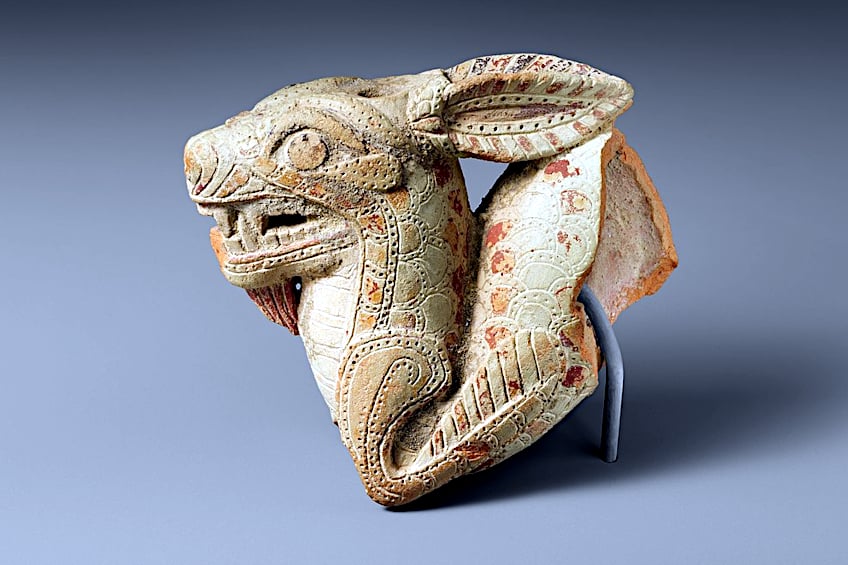
The image of the Greek ketos was formed in the Archaic period and for hundreds of years, the consistency of its iconography endured, even lasting well into Roman Imperial times. After Alexander the Great’s (r. 331–323 BCE) conquests, it was one the creatures that journeyed to the East. There, it occurred in the art of the Gandhara.
From Afghanistan to India, the ketos influenced the portrayal of monsters, and is thought to have been a partial inspiration for the Chinese dragon.
Sounion Kouros (600 BCE)
| Artwork Title | Sounion Kouros |
| Artist | Sounion Artists |
| Date | 600 BCE |
| Medium | Marble |
| Dimensions (cm) | 305 |
| Current Location | National Archaeological Museum, Athens, Greece |
This work is one of the earliest examples of kouros statues. It was made to be a temple votive and was discovered in Sounion at the Sanctuary of Poseidon in 1906. The marble of which it is made was from Naxos, and it is especially large, measuring 305cm. Even though it is an early work, classic kouros characteristics can be observed in the statue’s boxy form, long braided hair, rigid stance with one leg forward. Compared to later Greek sculptures that contain more movement, these kouros figures are more stylized and still.
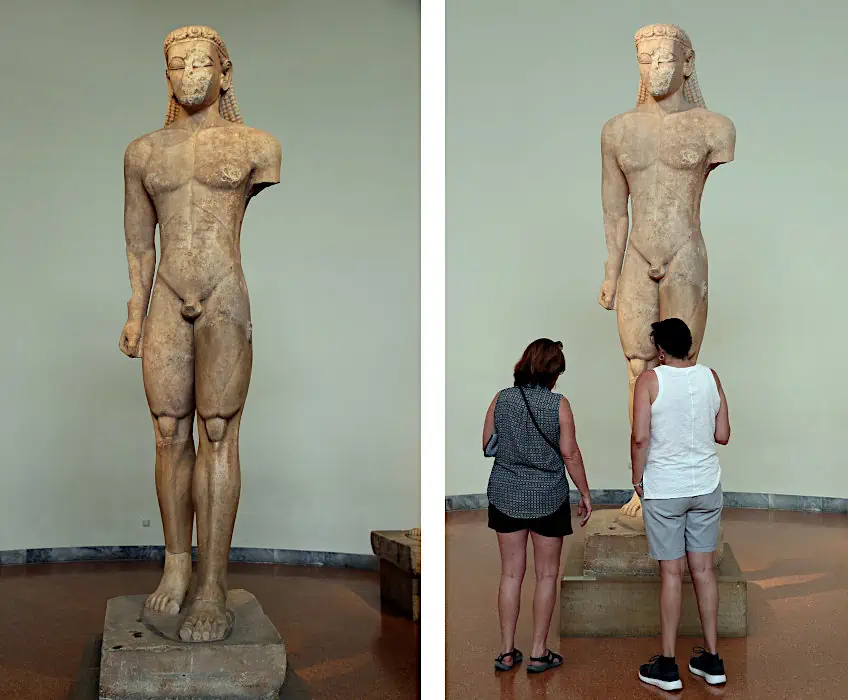
Sphinx of the Naxians (570 – 560 BCE)
| Artwork Title | Sphinx of the Naxians |
| Artist | Naxian artists |
| Date | 570 – 560 BCE |
| Medium | Marble |
| Dimensions (cm) | 222 |
| Current Location | Delphi Archaeological Museum, Delphi, Greece |
Also known as the Sphinx of Naxos, the Sphinx of the Naxians (570-560 BCE), this marble statue depicts a mythical monster with the head of a woman, and a feathery chest and wings of a bird of prey. The rest of the figure is that of a lioness. Originally, the statue stood on a column that measured 10 meters, and was placed in Delphi next to the Temple of Apollo.
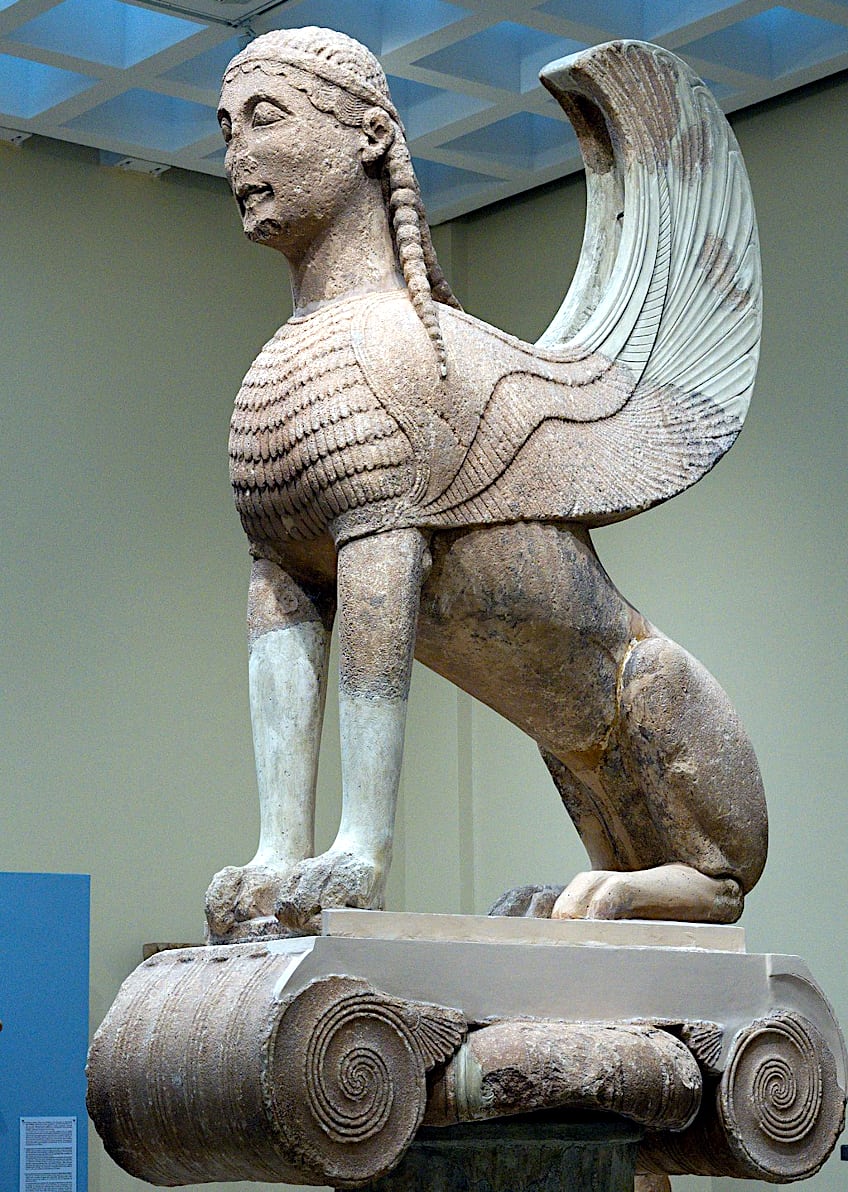
Naxos was one of the richest of the Cycladic islands around 560 BCE, and they originally erected this statue and stele as an offering to the Temple of Apollo. The total measurement of the work, including the statue, the column, and the base would have been 12.5 meters tall. The Greek Sphinx was believed to be fiercely strong and often served as guardians to entrances of temples.
Terracotta Column-Krater (c. 550 BCE)
| Artwork Title | Terracotta column-krater |
| Artist | Lydos (before 560 – c. 540 BCE) |
| Date | c. 550 BCE |
| Medium | Terracotta, black-figure painting |
| Dimensions (cm) | 56.4 x 69.3 |
| Current Location | The Metropolitan Museum of Art, New York City, United States |
This Terracotta column-krater, or container for mixing water and wine, has been attributed to the Athenian vase painter, Lydos (before 560 – c. 540 BCE), who painted in the black-figure style. On the vase a symposium is depicted, normally interpreted as a party of drinking. This occasion was a well-established tradition of Greek society, especially Athenian society. Depictions on vases for more than a century have recorded that wine, and song were important elements.
Respectable women were excluded, but courtesans known as hetairai frequented symposia.
The symposium was a practice that allowed citizens to come together, to engage in discussion, and transact business. The krater was essential as wine and water would be diluted within it and then used to serve the beverage.
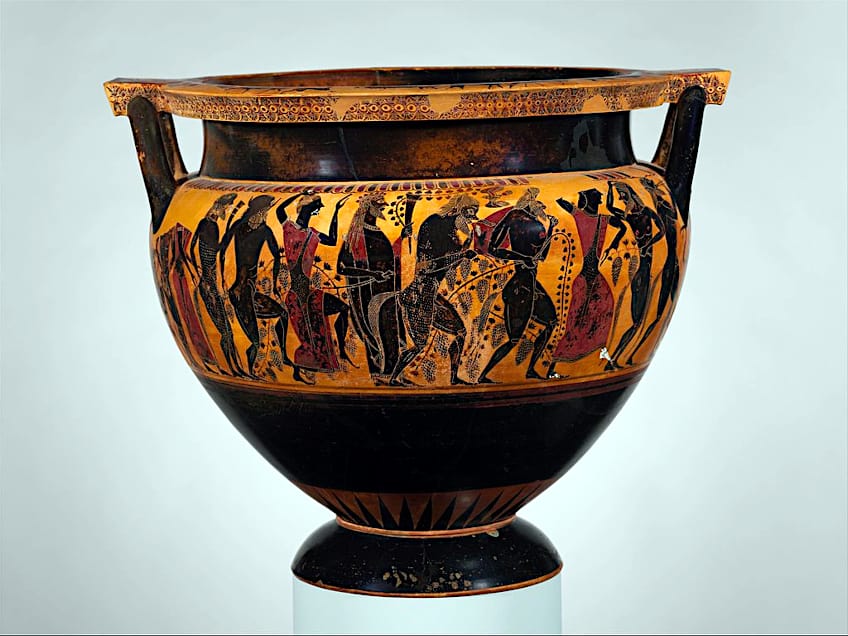
During the last quarter of the sixth century BCE, black-figure vase painting on kraters mostly focused on mythological themes, while the symposium was depicted on red-figure vases. What makes this krater significant is that it is one of the first to depict women, wine, and song, though mythological in appearance.
On both sides of the vase the subject of Hephaistos’ return to the home of the gods, Mount Olympus.
He was a divine smith, born of Hera and Zeus, and because he was born lame, he was cast out by his mother. Hephaistos made a throne that held Hera fast as revenge, and she could only be released by him. He was therefore given wine and Dionysus, the god of wine, took him to Mount Olympus. His male (satyr) and female (maenad) followers accompanied him.
Terracotta Painted Gorgoneion Antefix (540 BCE)
| Artwork Title | Terracotta painted gorgoneion antefix |
| Artist | Greek, South Italian, and Tarentine artists |
| Date | 540 BCE |
| Medium | Terracotta |
| Dimensions (cm) | 21 x 26.2 x 9.4 |
| Current Location | The Metropolitan Museum of Art, New York City, United States |
This antefix depicts a Greek mythological figure, the Gorgon. The earliest of Greek literature speaks of Gorgons, and while some descriptions of them may vary, they are most commonly referred to as three sisters with venomous living snakes for hair, and frightening faces that turned men who gazed upon them to stone. Medusa is the most famous of the three sisters, and was also the only one who was not immortal. Her life was ended by the hero and demigod, Perseus.
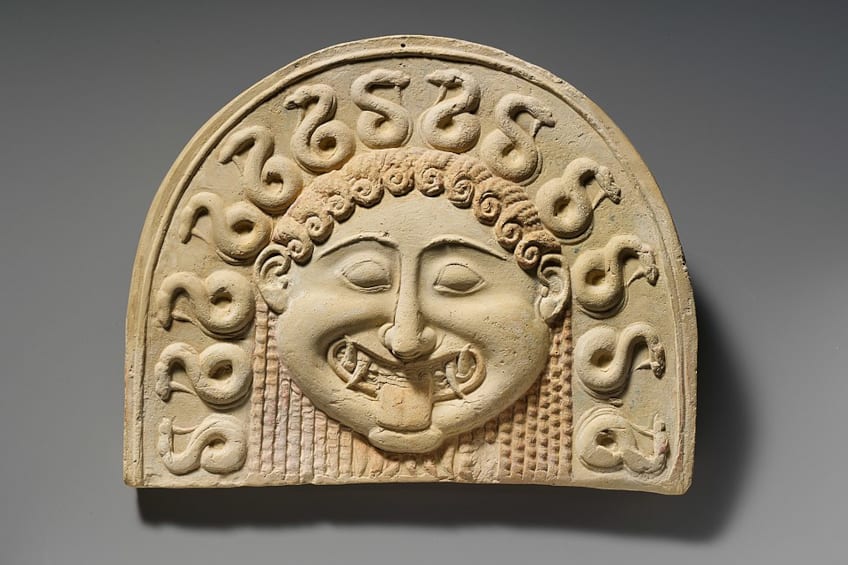
Gorgons are included in literature such as the writings of Homer (eighth century), and in records of religious beliefs of the ancient Greeks. Because Gorgons were well known in ancient Greece for their powerful, dangerous gaze, during the Archaic period images of them were widely used on temples and objects for protection, like this antefix.
Antefixes are ornamental roof tiles that are used to cover the ends of the joint tiles at the eaves of a building.
It serves to beautify the roof as well as protect it from the elements. Some depictions of Gorgons show them as having large eyes, wide round heads, broad mouths with swine tusks and projecting teeth, and hanging tongues. A few even have flared nostrils and short beards.
That concludes our article on Archaic Greek art and artifacts. We hope that you enjoyed learning about this period in art history, which was a time of development in Greece that laid the foundations for the Classical period in both culture and politics. As we see the more stylized and rigid Greek art form become more naturalistic, so do we see Greek culture and society adapt and develop as a whole, becoming more fluid while at the same time focusing on harmonious structures. We hope that this article inspires you to further your journey into the history of Greek art, and that it has given you a more rounded view of how Greek art has evolved over time.
Frequently Asked Questions
What Is Archaic Greek Art?
Archaic art is art that was made by the people of Greece during the Archaic period (650 – 480 BCE). During the Proto-Geometric and Geometric periods which preceded the Archaic period, Greek art was more rigid, with abstract geometric patterns and forms. During the archaic period, we see Greek art became more naturalistic. Vase paintings moved from geometric designs to include depictions of human figures. The faces of sculptures were given life with the Archaic smile, a symbol for health and vitality characteristic of the period, while the bodies were given more attention to anatomical detail and proportion.
What Are the Two Major Types of Art of the Archaic Period?
The two most notable types of Archaic period art are pottery and sculpture. This period is known for its move from geometric and stylized methods towards more realistic and figurative forms. Greek artists started producing monumental sculpture at this time, and bodies started having more life-like features, with more attention to anatomical detail and proportion. Pottery developed significantly from the repetitive patterns of the geometric period that preceded it to black and red-figure painting.
Jaycene-Fay Ravenscroft is a writer, poet, and creative based in South Africa, boasting over 6 years of experience working in a contemporary art gallery. She earned her Bachelor of Arts degree with majors in Art History and Ancient History from the University of South Africa, supplementing her studies with courses in Archaeology and Anthropology. Driven by a passion for learning, Jaycene-Fay finds inspiration in symbology and the interconnectedness of the world. Trained to analyze and critique art, she is enthusiastic about delving into the meanings behind each artwork, exploring its ties to the artist’s cultural, historical, and social context. Writing serves as Jaycene-Fay’s means of researching, sharing knowledge, and creatively expressing herself. For artfilemagazine, Jaycene-Fay writes articles on art history with a focus on historical paintings.
Learn more about Jaycene-Fay Ravenscroft and about us.
Cite this Article
Jaycene Fay, Ravenscroft, “Archaic Greek Art – Guide to Pre-Classical Artforms.” artfilemagazine – Your Online Art Source. October 9, 2023. URL: https://artfilemagazine.com/archaic-greek-art/
Ravenscroft, J. (2023, 9 October). Archaic Greek Art – Guide to Pre-Classical Artforms. artfilemagazine – Your Online Art Source. https://artfilemagazine.com/archaic-greek-art/
Ravenscroft, Jaycene Fay. “Archaic Greek Art – Guide to Pre-Classical Artforms.” artfilemagazine – Your Online Art Source, October 9, 2023. https://artfilemagazine.com/archaic-greek-art/.


